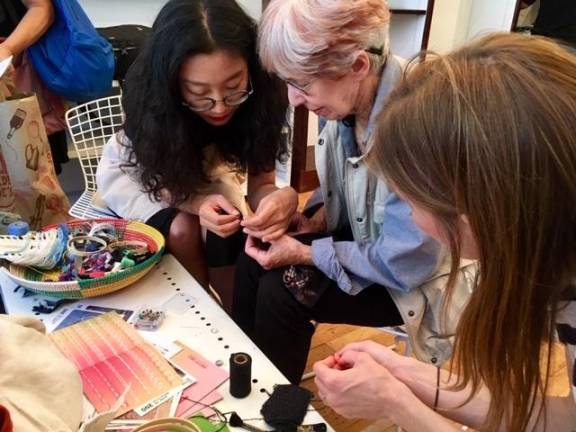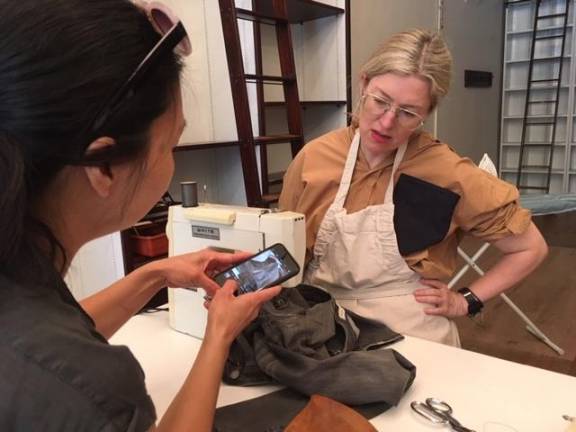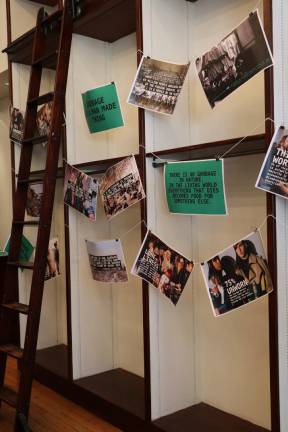An Upper West Side Mending Lab
Clothes repair pop-up creates communities aimed at trimming fashion waste



Ripped jeans, tattered T-shirts, a moth-eaten sweater, even beloved stuffed animals – all found their way to a one-day pop-up at the shuttered Steven Alan clothing store on Amsterdam Avenue near West 82nd Street.
Graduate students Tara Maurice and Tianyue “Caroline” Zhang hosted the workshop for their thesis called “Pretty/Ugly: Fashion, Waste & Consumption.” Their research for a Masters in Design for Social Innovation at the School of Visual Arts focuses on the economic, environmental and human costs of “fast-fashion.” They billed the Sept. 29th event as a way to learn a valuable life skill, while meeting friends, neighbors and others concerned about clothing waste.
“Jeans get better as they get older, right?” said one woman, who spotted the Mending Lab poster and returned with several damaged goods. “It’s always the one you love the most that gets the hole.”
Standing over a sewing machine, Maurice, a former fashion executive, revived piles of shirts and pants that would have become garbage. She sewed cloth patches on the inside to stabilize giant holes, before creating a web of stitching on the outside.
“In terms of solid waste, we basically throw away most of what we buy within a year of its original purchase. So, knowing that and being a designer, it got hard to be a designer,” said Maurice, who lives on the Upper West Side with her husband and children. “I’m trying to do a different kind of designing, which is designing a solution.”
"Extend the Life-Cycle"
The women hung samples of potential art-messaging around the room. “Fashion now is a system that makes things for consumers to throw away,” read one poster, a photo of scavengers on a landfill. Another showed two well-dressed women in winter coats, and a recent claim, “80 pounds: the amount of shoes and clothing the average Western consumer discards per year.”
Caroline Zhang hovered over a growing group of novices and veterans, demonstrating various hand-stitching techniques for mending tears, closing holes and reinforcing frayed seams.
“We buy things and just give them away, so I think it is important for us, not to make a new life, but to extend the life-cycle of all the stuff we’ve bought,” said Zhang, who studied sociology in China before interning at several fashion magazines.
“I can’t find it!” said Mary Beth Lumley, marveling at a once-visible hole in her favorite cardigan. “It’s a nice sweater, and I haven’t had the heart to throw it away or recycle it. I didn’t want to give it to Good Will or Salvation Army because there was a hole in it.”
A Social Experience
Others chose “visible mending,” a technique that uses decorative fabrics and elaborate stitching to show off repairs. Some say renewed interest in this technique is a deliberate rejection of cheap, disposable “fast-fashion,” along with a move toward owning fewer things and living in smaller spaces.
In no time, veterans were helping beginners, and novices were sharing their newfound skills with each other. The social nature of the pop-up surprised several people who grew up mending their belongings at home, often out of necessity.
“This is just great, to get together with other people out to repair things, plus to raise my consciousness about the clothing industry, which I never thought about,” said Amy Stone, an Upper West Sider who learned the skill as a Girl Scout.
“We want to create community where people can connect with each other by doing things with [their] hands, together,” said Zhang. “Not that we persuade people to say ‘you should not buy things.’ It’s impossible. But by making people get together, we ... make things happen.”
Financial Opportunity
There’s much to be done right here. The average New Yorker tosses out 46 pounds of clothing and other textiles, or nearly 200,000 tons annually, according the City’s Department of Sanitation (DSNY). This fiscal year, DSNY budgeted more than $412 million to export its garbage to landfills as far away as South Carolina. In 2016, it launched “donateNYC, ” an initiative to prevent reusable electronics, furniture and other items from entering the waste stream. Last year the program diverted more than 11,500 tons of textiles and clothing from landfills.
There’s also a growing financial opportunity in salvaging garments. The sanitation department’s “NYC Reuse Sector Report 2019” found 432 retailers and community organizations engaged in the reuse, recycling or resale of clothing, up from 375 in 2017. Recent surveys suggest more shoppers consider resale value when buying clothes, and big corporations are, at least, talking about “sustainable” production processes.
Zhang and Maurice say solutions will be difficult because the problems are so complex. The thesis of their graduate study remains a work in progress. But they were thrilled with the turnout at the Mending Lab. More than 30 people dropped in for a chance to learn – or remember – how to mend their garments using needles, thread and patches of recycled fabric. So many people took part - and wanted to stay so long - that the three-hour event went on for five hours.
For more information on NYC Sanitation Department’s reuse and recycling programs, visit:
“I’m trying to do a different kind of designing, which is designing a solution.” Graduate student Tara Maurice